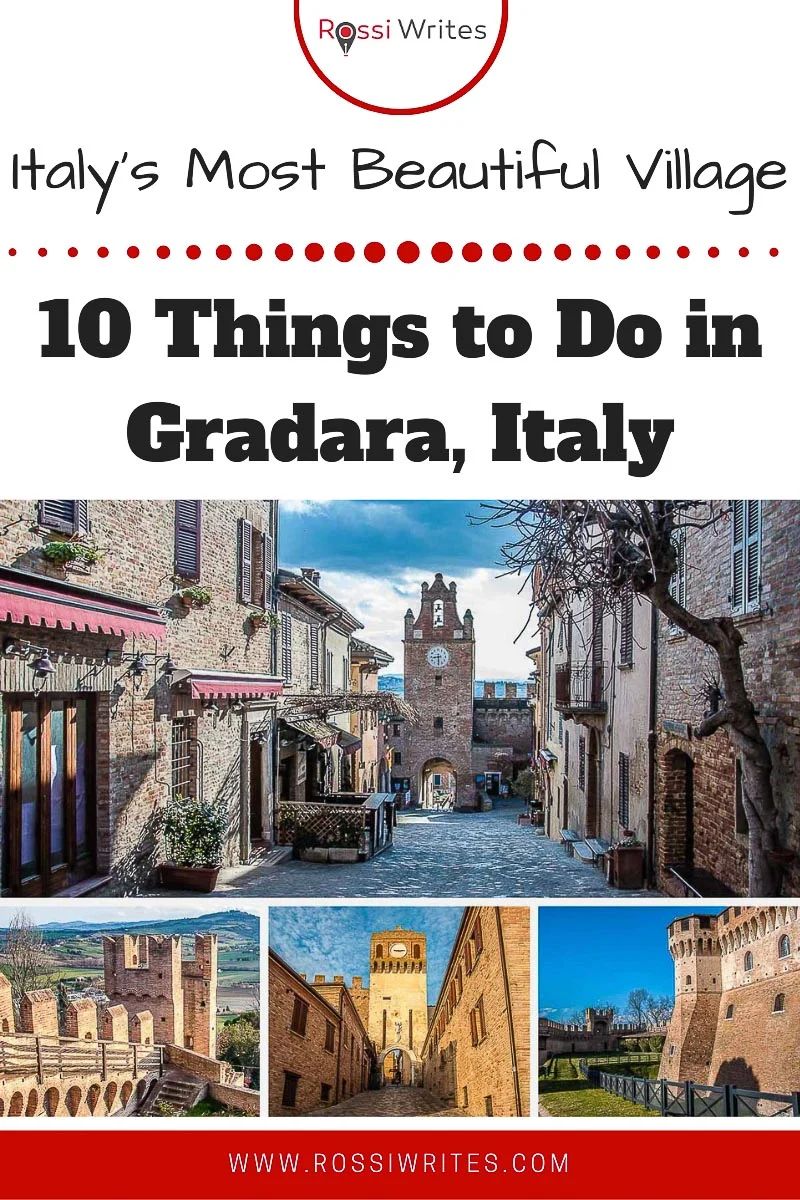Gradara is a fortified medieval village that was declared Italy’s most beautiful in 2018.
Famous as the setting of the tragic love story of Paolo and Francesca – referenced by Dante in his Divine Comedy – Gradara crowns a small hill that opens beautiful panoramic views over Italy’s Adriatic seaside.
The village is in the Central Italian region of the Marche and it’s right on its border with the Northern Italian region of Emilia-Romagna. As such, it’s within close proximity to several Italian art cities, historic towns, and sea resorts, plus the world’s oldest republic – San Marino.
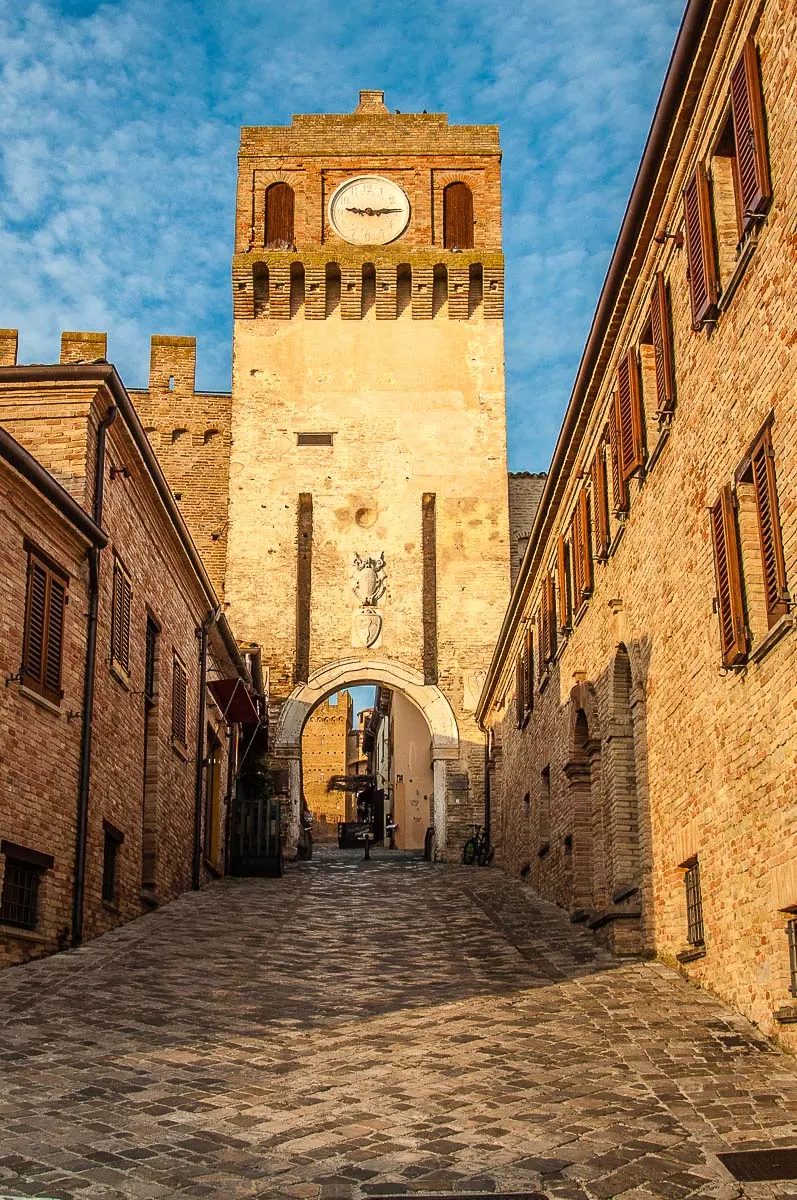
With a majestic castle that, throughout the centuries, has been home to some of Italy’s most famous noble families, Gradara is a delight to explore. Especially, if you have always wanted to find yourself in a fairytale-like medieval setting.
One of Italy’s most popular sights and attracting hundreds of thousands of visitors a year, Gradara has many stories to tell and many hidden gems to explore. Built on a hill that is crisscrossed by tuff caves and tunnels, the village is fortified by two rings of defensive walls. The outer one is 800 m long!
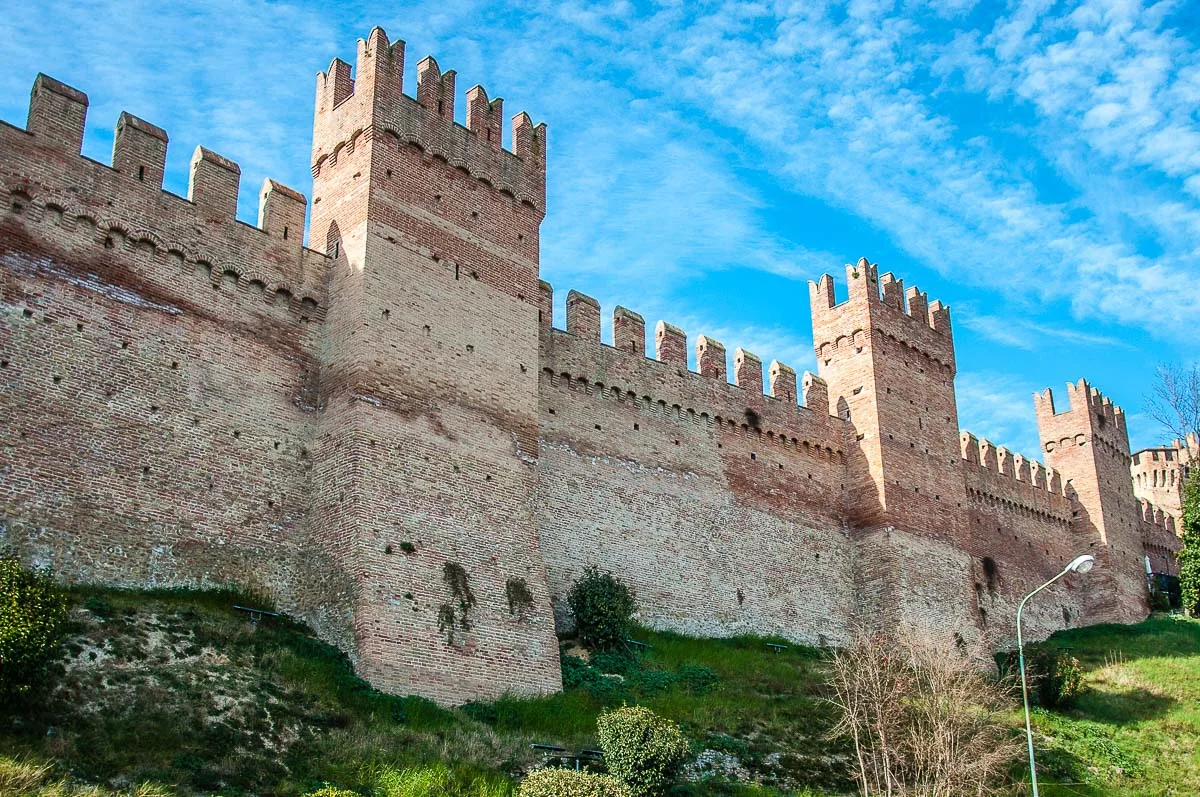
What makes Gradara particularly interesting is that this is where some of Italy’s most intriguing in terms of their character and history women have lived and loved. Starting with Francesca – who has come to symbolise the free choice in who we fall in love with – to Lucrezia of the scandal-ridden Borgias, the village and its castle preserve to this day the memory of their lives.
So, if you are looking for beautiful corners with curious stories to visit in Italy, then Gradara is a great destination. This is a place where you can feel the echo of Italy’s history in all its multilayered glory. And yet, this is a place developed to easily accommodate the needs and requirements of tourists.
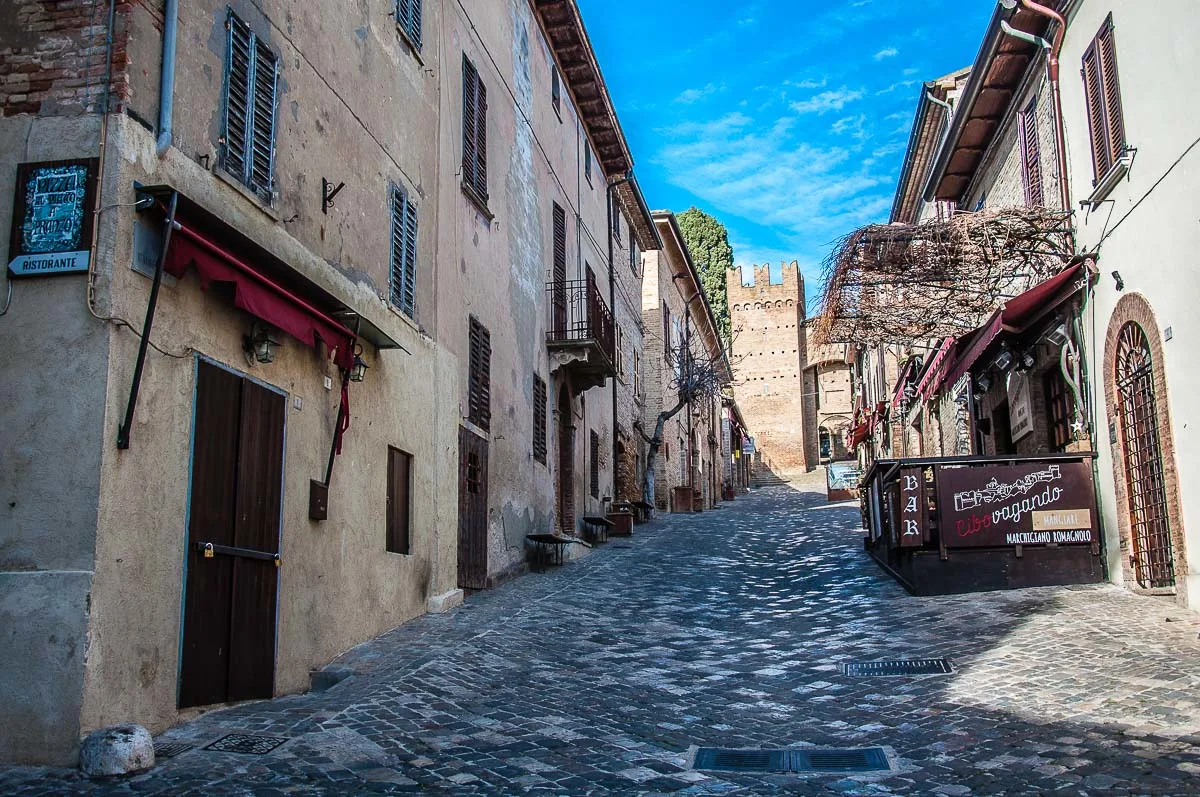
There are many things to do in and around Gradara to happily fill a couple of hours, half a day or a whole day of relaxed exploration during your Italian holiday. In this blog post, I will tell you all about them and will give you helpful pointers to make your visit to Gradara in the Marche a truly exciting adventure.
From answers to such questions as ‘where is Gradara in Italy’ and ‘how to get there’ to a list with the best sights to see in this fortified village, it’s all organised in logical chunks of practical information to make your travel planning as easy as possible.
I had the chance to spend a lovely day in Gradara during a road trip through Emilia-Romagna and the Marche. Now, I want to share it all with you so as to galvanise you to discover this beautiful Italian destination that seems to transport its visitors straight back in time to the Middle Ages.
Have a look!
10 Things to Do in Gradara – Italy’s Most Beautiful Village for 2018
Where is Gradara, Italy?
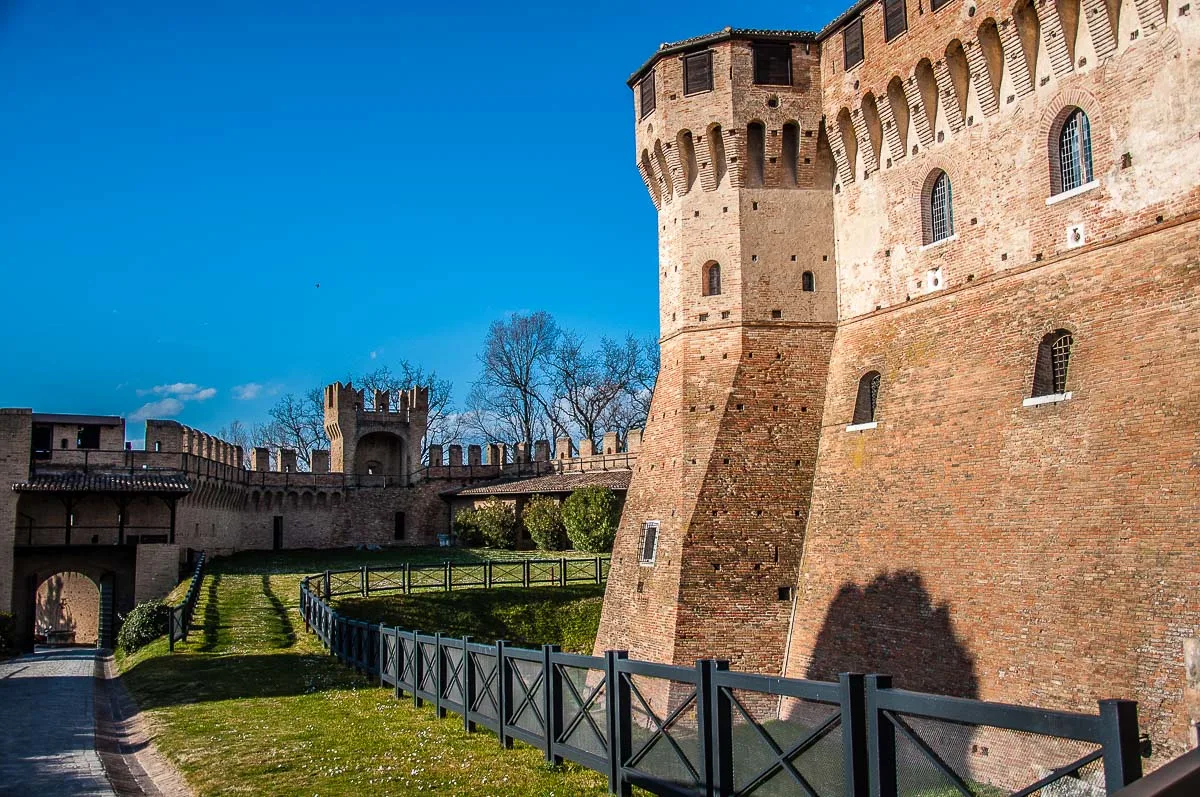
Gardara is a small village in Italy with just under 5,000 inhabitants. You will find it in the Province of Pesaro and Urbino which is part of the Central Italian region of the Marche. Gradara is right next to the Marche’s border with the Northern Italian region of Emilia-Romagna.
It’s the first thing you see when you drive from Emilia-Romagna into the Marche. Gradara’s massive castle and defensive walls crown the top of a small hill. They suddenly come into view and seem to loom above the motorway. It’s a really impressive sight and it entices you to stop and have a look.
Gradara is respectively 17 km and 30 km away from the provincial capitals of Pesaro and Urbino in the Marche. The towns closest to it though are Cattolica (in Emilia-Romagna) and Gabicce Mare (in the Marche). Both are less than six km away from Gradara. If you are travelling by public transport, you can travel by train to the train station of Cattolica-S.Giovanni-Gabicce before catching a bus to Gradara.
Other nearby towns and cities that offer easy access to Gradara are Fano (32 km away), Rimini (33 km away), Ancona (85 km away), Ravenna (89 km away), and Bologna (138 km away). Gradara is also only 42 km away from the Republic of San Marino.
Gradara is right between the Adriatic coast on one side and the Marche’s rolling hills on the other. Standing atop the hill which it crowns, you can enjoy fantastic and long-reaching views up and down the Italian Adriatic seaside. And then you turn around and the panorama is completed by the lush hilly landscape of the Marche.
It’s a beautiful area and you begin to understand why Gradara was built there in the Middle Ages. Its position is very strategic – on one hand, it is close to all of the large cities and towns in the area. On the other, it overlooks a large territory and at the time, approaching enemy troops would have been spotted from afar.
Why Visit Gradara, Italy?
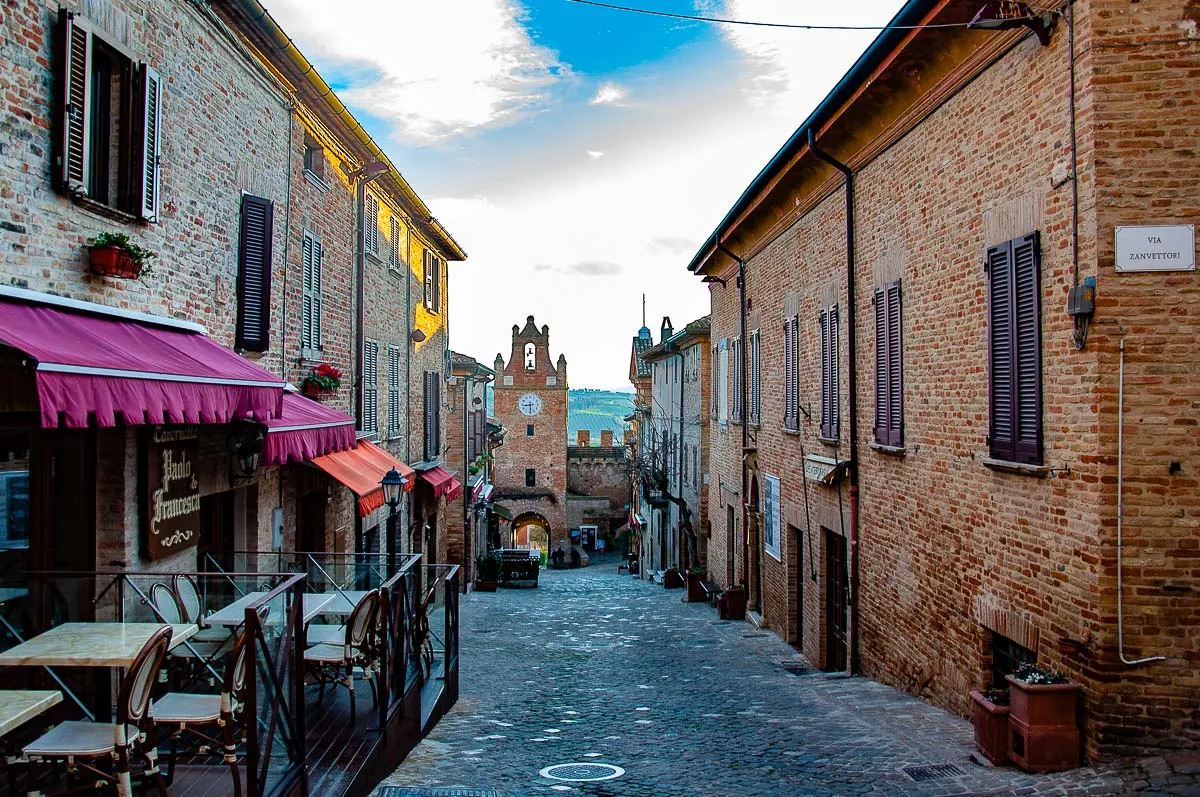
Known as the Capital of the Middle Ages, Gradara is a beautiful fortified village huddled next to an impressive castle with a centuries-old history. Carefully restored to its medieval strength and beauty, Gradara is considered to be one of the best-preserved monuments of that era in Italy. Over the last few years, Gradara has received many accolades. Most notably, it was selected as Italy’s most beautiful village for the year 2018.
If you have always dreamt of experiencing the Middle Ages, Gradara in Italy is a great destination. Well-developed to meet the needs of travellers and tourists while preserving its original atmosphere, the village and the castle of Gradara represent an extraordinary urban and architectural combination.
Throughout the centuries, some of the most powerful families of Italy of the Middle Ages and the Renaissance owned and ruled Gradara. From the Malatesta and the Sforza to the Borgias and the Delle Rovere, here you can walk in the steps of strong historic figures and hear first hand the echo of events that have reverberated through the history, arts, and literature of Italy and Europe.
Gradara is, above all, known as the place where one of the world’s most famous love stories blossomed before reaching its tragic ending. On a September day in 1289, the unfortunate lovers Paolo and Francesca were killed by the sword of her jealous husband Gianciotto. Their love has been immortalised by poets and writers such as Dante, Bocaccio and Petrarch and by artists like Gustave Dure and Auguste Rodin.
Gradara’s fate is also tightly interlaced with that of some of the most interesting women in Italian history. Walking through the streets of the fortified village and visiting the frescoed rooms of Gradara Castle, you can see the place that ladies such as Lucrezia Borgia and Vittoria Farnese called home.
Above all, Gradara is a fun place to visit. This fortified village organises many lively events all throughout the year. From a romantic celebration of St. Valentine’s Day to a biennial large medieval reenactment, from demonstrations of court life held every Thursday during the high season to a Celtic festival in autumn, Gradara is a great place to delve into the past and to have fun in the present. All in a beautiful historic setting surrounded by the lush hills and the sparkling Adriatic Sea of Central Italy.
What Are the Best Things to Do in Gradara, Italy?
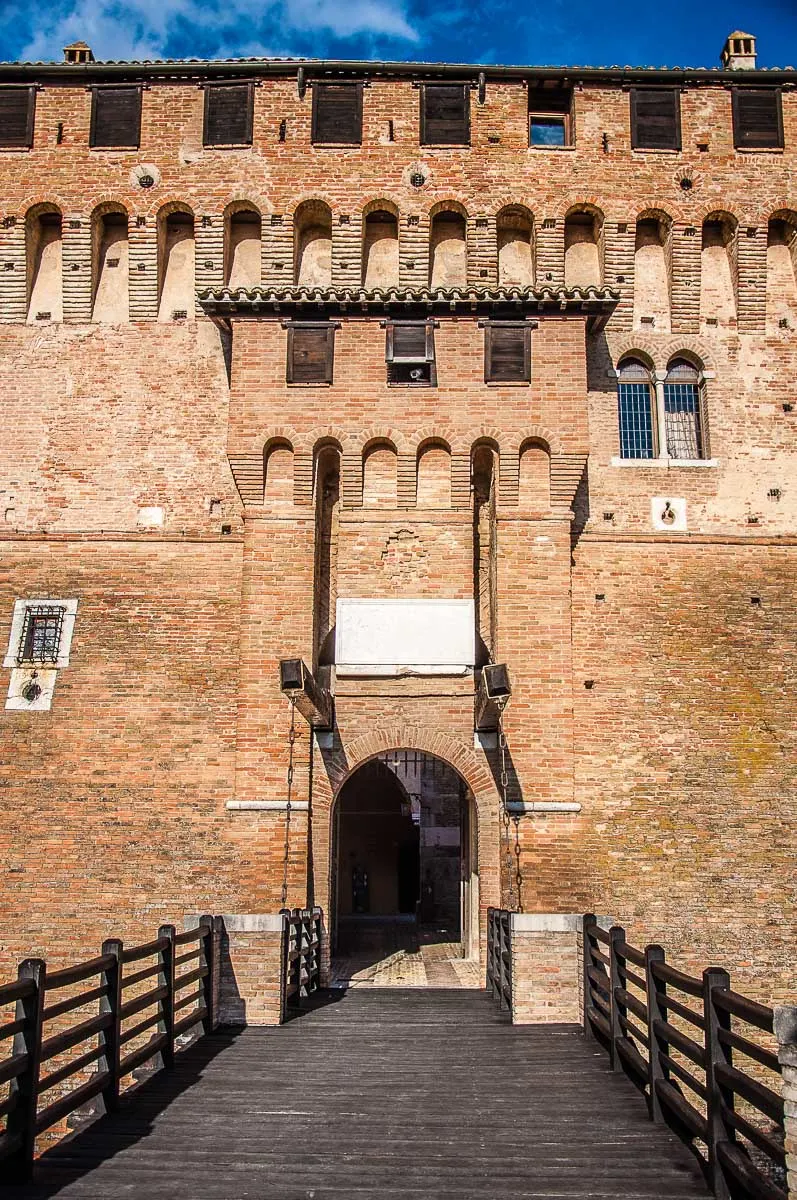
Small and compact, Gradara offers a nice selection of things to do and see. They will entice lovers of history, seekers of beauty, chasers of romance, and people who simply want to experience one of Italy’s most fully restored historic settings.
Here is a shortlist of the ten best things to do in Gradara, Italy. Most of them are within the village’s very walkable historic centre. A couple will entice you to go for a very short walk just beyond its double defensive walls.
1. Medieval Defensive Walls of Gradara, Italy
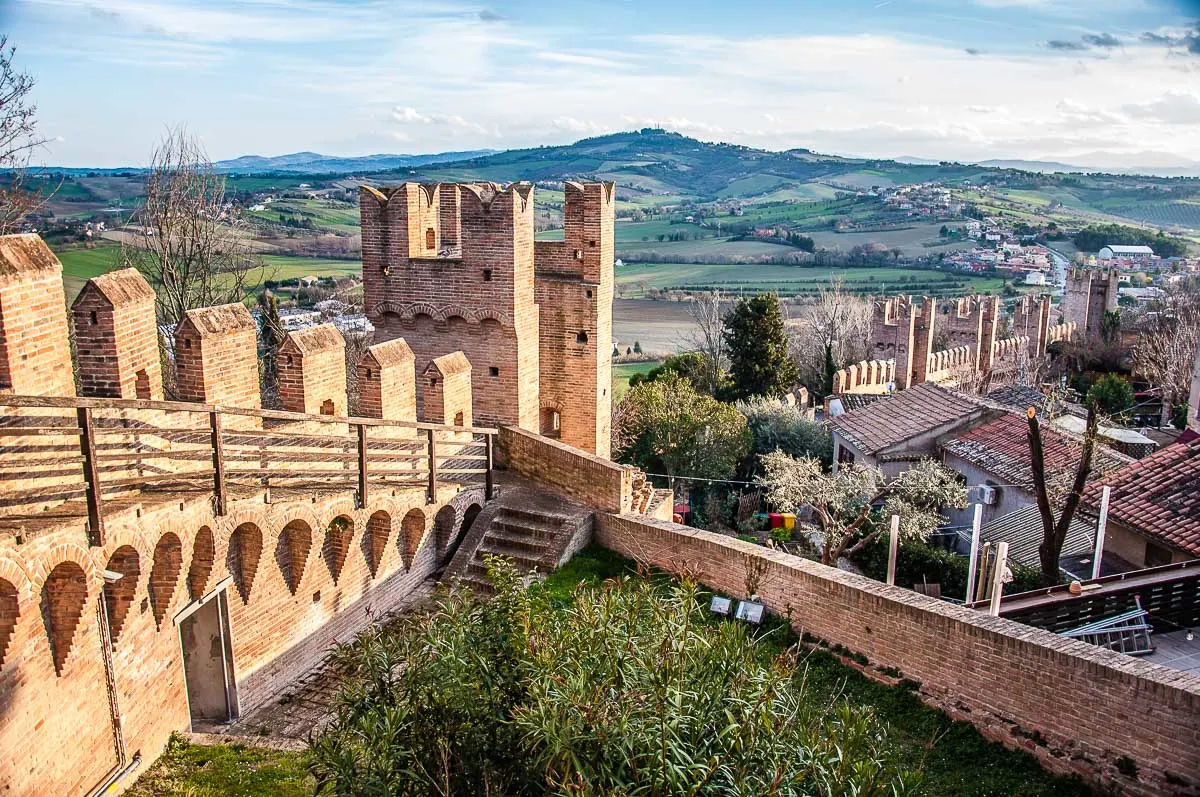
Gradara is surrounded by a double ring of defensive walls. Originally erected in the early 14th century, they were extensively restored during the 20th century and are considered to be one of the best-preserved of their kind in Italy.
The external wall is about 800 m long and envelopes both Gradara Castle and the small historic village next to it. The inner wall runs around Gradara Castle only.
There are 14 square crenellated towers dotted along Gradara’s defensive walls. La Rochetta – a small 15th-century fortress forms part of the walls on the side overlooking Italy’s Adriatic coast.
2. Gradara Castle in Gradara, Italy
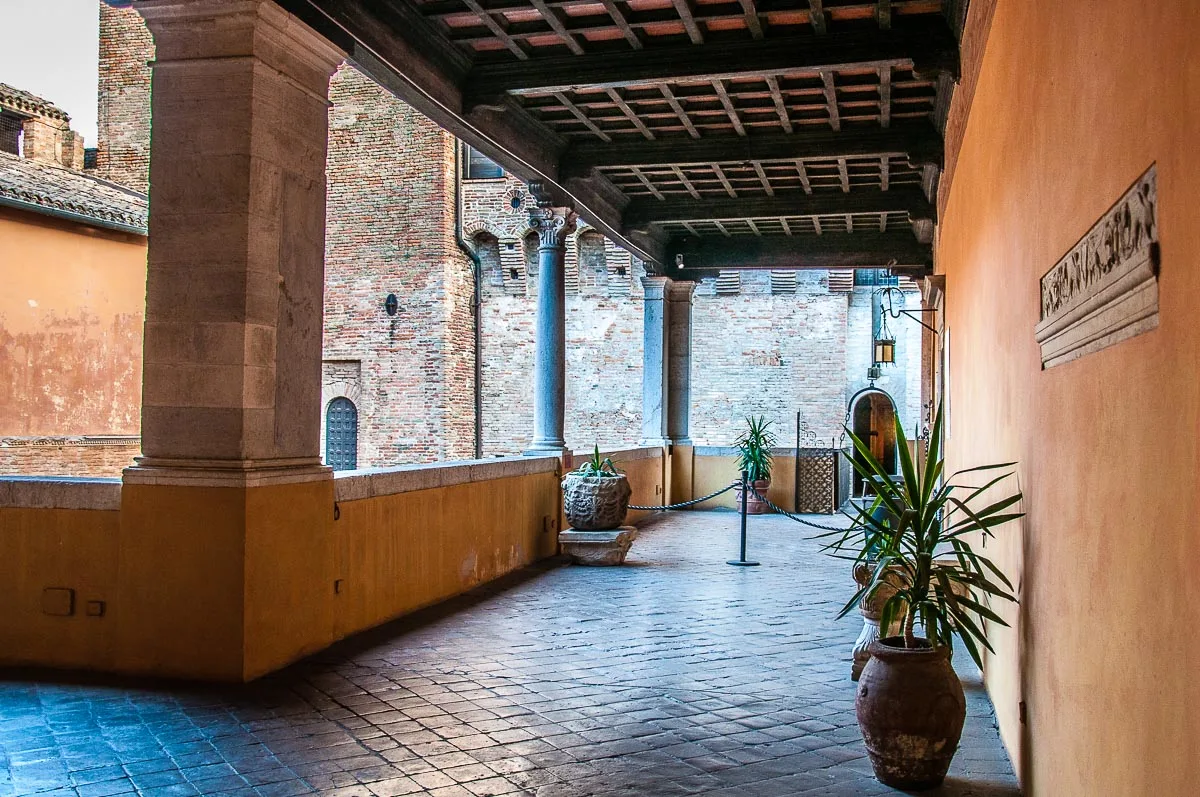
Gradara Castle is the most important building in the small fortified village.
You will see it perched on the highest spot of the small hill down which the houses of Gradara cascade. From its height of 142 m above sea level, the castle enjoys far-reaching views over the Adriatic Sea and the hills of the Marche.
Having started life back in the 12th century as a single defensive tower, the castle was greatly enlarged, built and re-built throughout the following centuries around its original nucleus. The list with the names of its owners reads like a Who’s Who of Italy’s medieval and Renaissance nobility. For the castle was ruled by the members of such notorious families as the Malatesta, the Sforza, the Borgias, and the Delle Rovere.
In 1920, Gradara Castle was purchased by an Italian engineer – Umberto Zanvettori. He spent many years restoring the castle and filling it with antique furniture and precious art pieces. Upon his death, the ownership of Gradara Castle passed to the Italian State with the provision that Eng. Zanvettori’s wife could spend the rest of her life there.
Nowadays, the castle is a must-see even if you are in Gradara for a very short amount of time. Exploring its rooms – eclectic in their mix of original medieval frescoes and restoration works completed by Eng. Zanvettori – is like opening a door to the history of this corner of Italy. Also here, you can admire original art pieces by Giovanni Santi (father of the famous artist Raphael) and Andrea della Robbia (a renowned sculptor of the Italian Renaissance, specialised in glazed ceramics).
3. The Love Story of Paolo and Francesca in Gradara, Italy
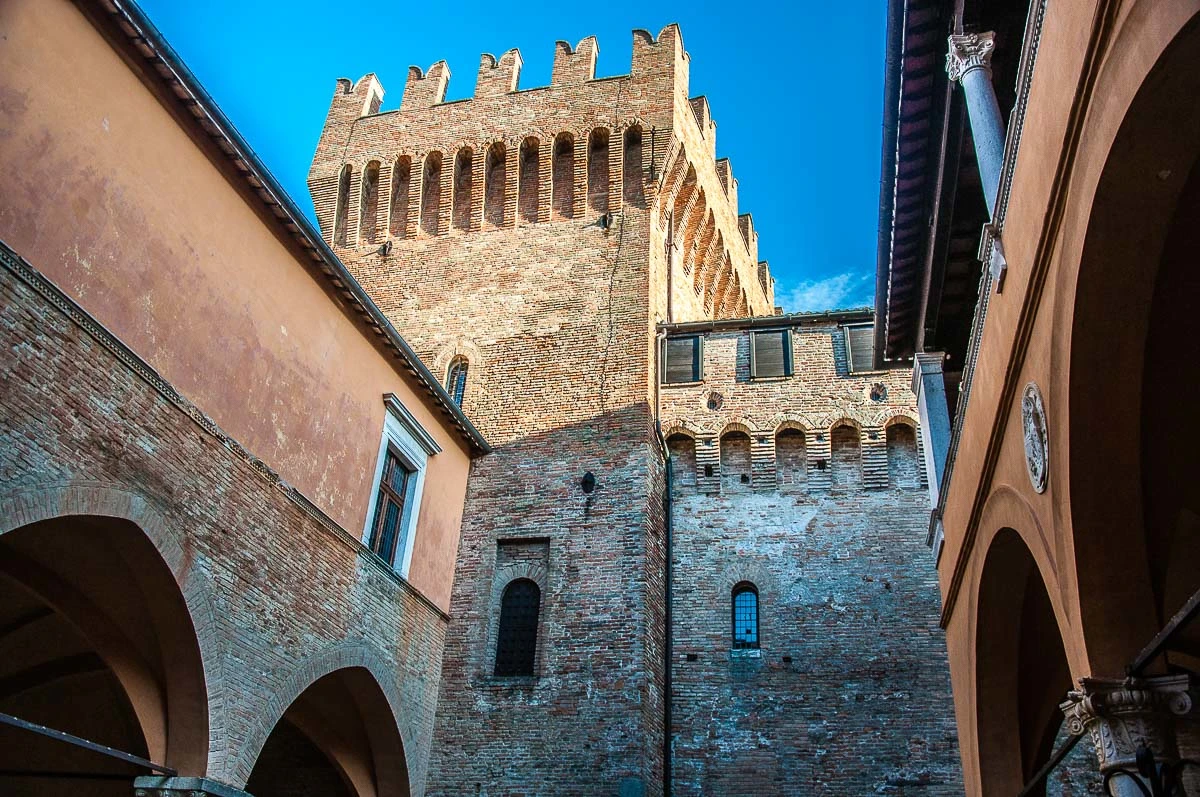
Paolo and Francesca’s story is one of the most well-known love stories of the Middle Ages in Europe. It was so popular at the time that poets and writers of the rank of Dante, Bocaccio, and Petrarch wrote about it in their works of literature. Throughout the centuries that followed, the two tragic lovers have inspired many artists and have become the central characters of operas and paintings.
The most famous interpretation is in Dante’s Divine Comedy. In Canto V of Inferno, upon his descent into Hell, Dante meets Paolo and Francesca. For their adulterous love, they have been confined to the second circle of Hell, reserved for the lustful. Yet they have the comfort of being together in the afterlife.
Francesca da Polenta (also known as Francesca da Rimini) was a young and beautiful girl who entered into an arranged marriage with Giovanni Malatesta – an ally of her father. Giovanni was known as Gianne lo Sciancato (or Gianciotto) which in English translates as Gianne the Cripple on account of him being born with a physical deformity.
Gianciotto, allegedly, was not a very nice person. To convince Francesca to marry him, a plan was put in motion both by him and Francesca’s father. Paolo – the younger brother of Gianciotto – was sent to marry Francesca by proxy. In other words, he stood in for the groom during the wedding ceremony in 1275 but he was not the groom himself. Plus, he was already married and had two children. Yes, they did things differently in the Middle Ages!
Paolo was very handsome. In fact, he was known as Il Bello (The Beautiful). Francesca must have been very hurt upon discovering the betrayal but she accepted the hand that fate had dealt her. She lived with Gianciotto in Gradara Castle for many years and bore him a daughter – Concordia.
Throughout the years, Francesca grew emotionally close to Paolo and this set the tongues wagging. One day in September 1289, Gianciotto caught Paolo and Francesca in the act of exchanging a chaste kiss after having read together the love story of Lancelot and Guinevere. Enraged, Gianciotto killed the lovers thus cementing their story in Europe’s romantic imagination.
Nowadays, Gradara makes the most of this legacy. Here are the spots around the village where you can feel close to Paolo and Francesca:
Francesca’s Room in Gradara Castle – apparently, this is the room where the two tragic lovers were attacked and killed by the enraged Gianciotto. The room is even outfitted with the trap door through which Paolo tried to escape the sword of his brother. In fact, the room was chosen and outfitted by Eng. Zanvettori during his extensive restorations of Gradara Castle in the 1920s. One of the things you can see here nowadays is the reproduction of the lavish dress worn by the famous Italian actress Eleonora Duse in the 1901 film ‘Francesca da Rimini.
Lovers’ Lane – this is a small path starting from the Eastern Gate of the defensive walls and going across the small hill of Monte delle Bugie. It links Gradara Castle to the Forest of Paolo and Francesca. Perfect for a romantic stroll with the one you love.
Paolo and Francesca’s Forest – a small forest where, some say, the two famous lovers would go to spend fleeting moments together. A hiking path, just over a kilometre long, crosses the forest.
4. Historic Museum and Underground Caves in Gradara, Italy
This is a small private museum introducing you to the history of Gradara. In its neatly organised rooms, you can see several artefacts and documents revealing how life used to be here during the Middle Ages. Instruments of torture, ancient arms, folkloric costumes and objects of daily life build a rich picture of times long gone by.
The most interesting thing about Gradara’s Historic Museum is that it gives you access to the tuff caves running through the hill on which the medieval village stands. These caves and tunnels date back to the 5th/6th centuries. Their origin is ancient and shrouded in mystery. One of the theories is that they were used for clandestine meetings by the followers of a Byzantine cult. After all, Ravenna – at the time the capital of the Western Roman Empire and later on of the Ostrogothic and Byzantine Italy – is just up the road from Gradara.
During the Middle Ages, the caves and the tunnels were, allegedly, used as a quick escape route in case of a siege or attack. Nowadays, there are about 16 such underground caves in the bosom of the hill of Gradara. Ten of them are accessible but only the cave underneath the Historic Museum is open to visitors.
You can learn more at the museum’s official website here (in Italian).
5. Porta Firau and Clocktower in Gradara, Italy
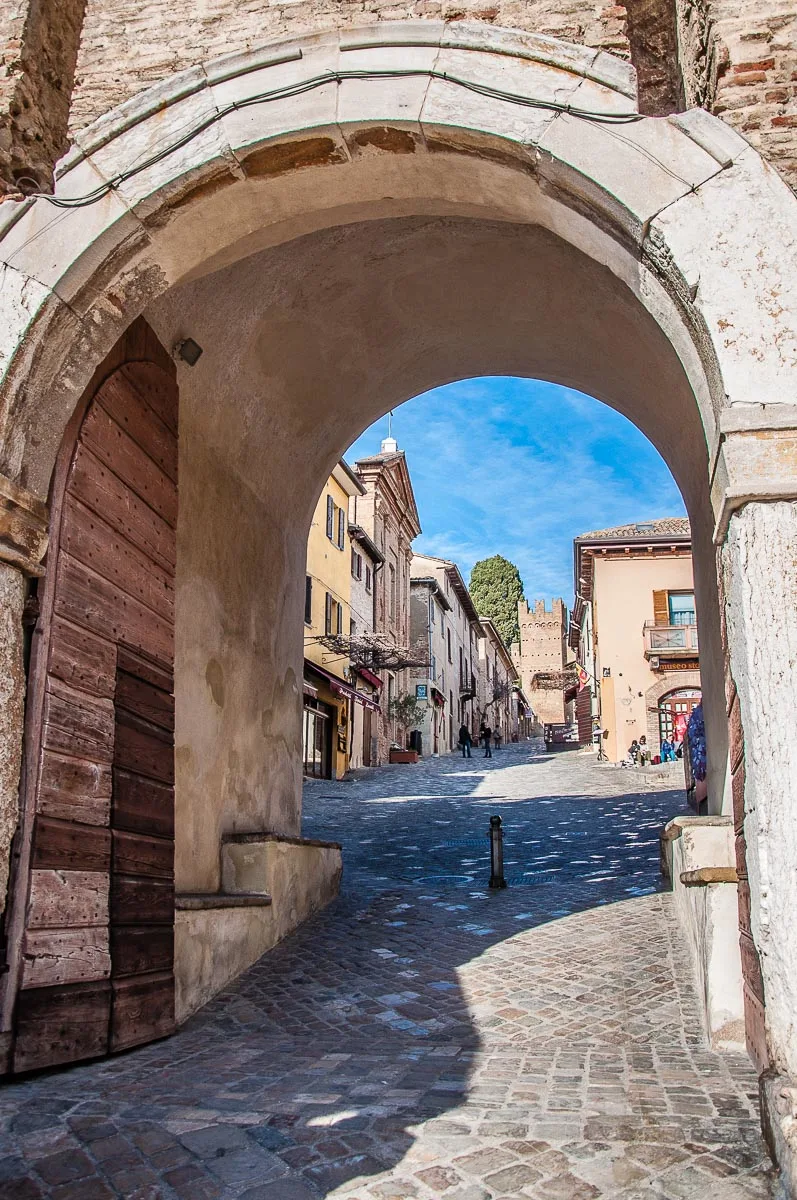
Porta Firau is an imposing medieval gate. It’s crowned by a square clock tower decorated with the coats of arms of the noble families that ruled Gradara during the Middle Ages and the Renaissance.
Porta Firau was the village’s only point of entry in the Middle Ages. Originally, it had a drawbridge and a defensive moat. Both were replaced in the 17th century with a ramp and a wooden gate which are still there nowadays.
The guardian of the gate was one of the most important people in the village. Until the beginning of the 20th century, Porta Firau would still be closed and locked each evening at the Hour of Ave Maria (the time of the evening prayers). It was then only unlocked and open at sunrise.
In order to fully appreciate the might and height of Gradara’s medieval defensive walls, you can pay a small fee and go for a walk on the ramparts. The access point is next to Porta Firau. About 300 to 400 m of the patrol walkways are open to the public seeking to enjoy the views and feel like a medieval guard patrolling the fortified village.
6. Churches in Gradara, Italy
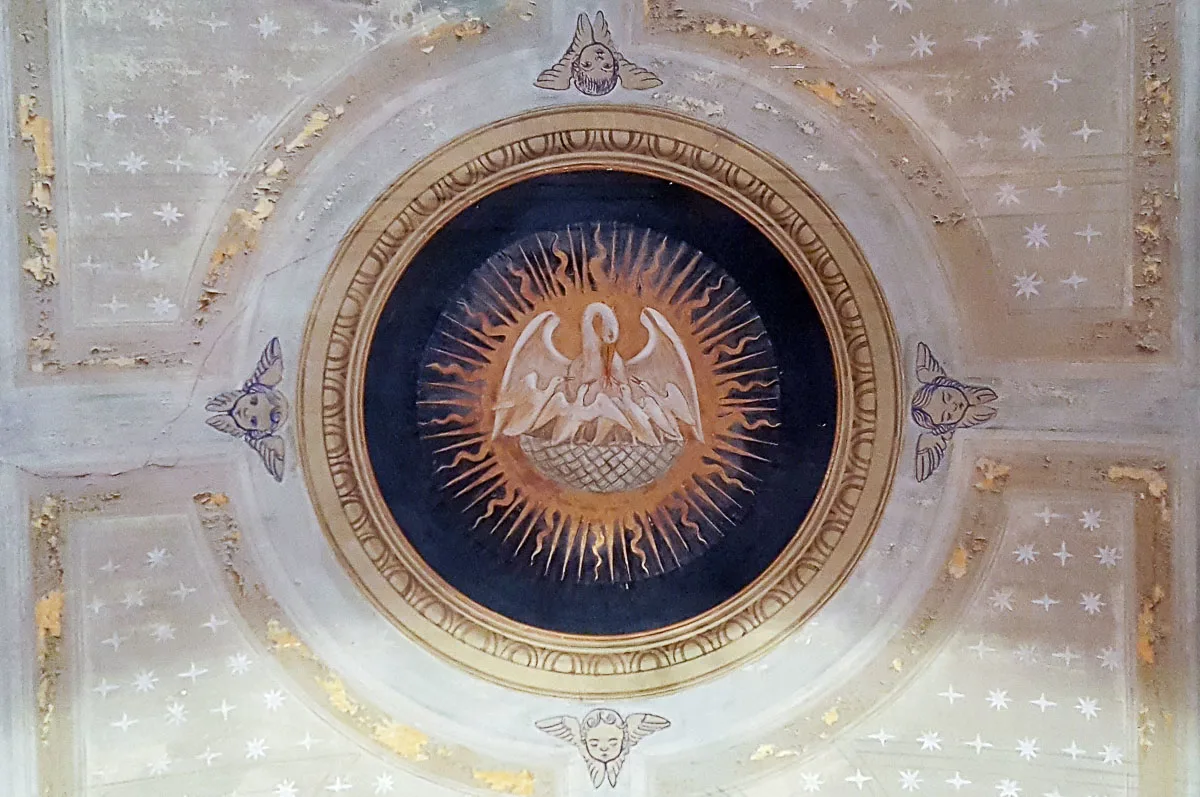
There are two churches in the fortified village of Gradara. Both are small and both have an interesting history. The Church of the Holy Sacrament is closer to Porta Firau. The Church of San Giovanni Battista is just up the street. It stands next to the second ring of defensive walls which circle Gradara Castle.
Church of the Holy Sacrament – this is a 16th-century church founded by Duchess Vittoria Farnese for the Brotherhood of the Holy Sacrament. It was then rebuilt in 1750. Here you can admire a rare 18th-century organ by Gaetano Antonio Callido who was also in charge of the organs of the Basilica of St. Mark in Venice. St. Clement’s relics – a martyr from the 2nd century – are also preserved in a glass coffin inside this small church.
Church of San Giovanni Battista – originally built before 1290, this church was particularly favoured by the Malatesta and the Sforza families who called Gradara home for centuries. The church was destroyed during an earthquake in the 17th century with its medieval facade surviving. In the 18th century, the church was restored by the Mosca Barzi noble family who at the time owned Gradara. The most interesting work of art here is a 16th-century incredibly realistic wooden Crucifix. They say that if you look at the face of Christ on the cross from three specifically defined spots, you can see the three intense expressions of his Passion. As such, looking from the right side, you see the suffering of Christ. Looking from the front, you can see the last moments of the agonising Christ. And looking from the left reveals the face of Christ right after he has expired.
7. Historic Buildings in Gradara, Italy
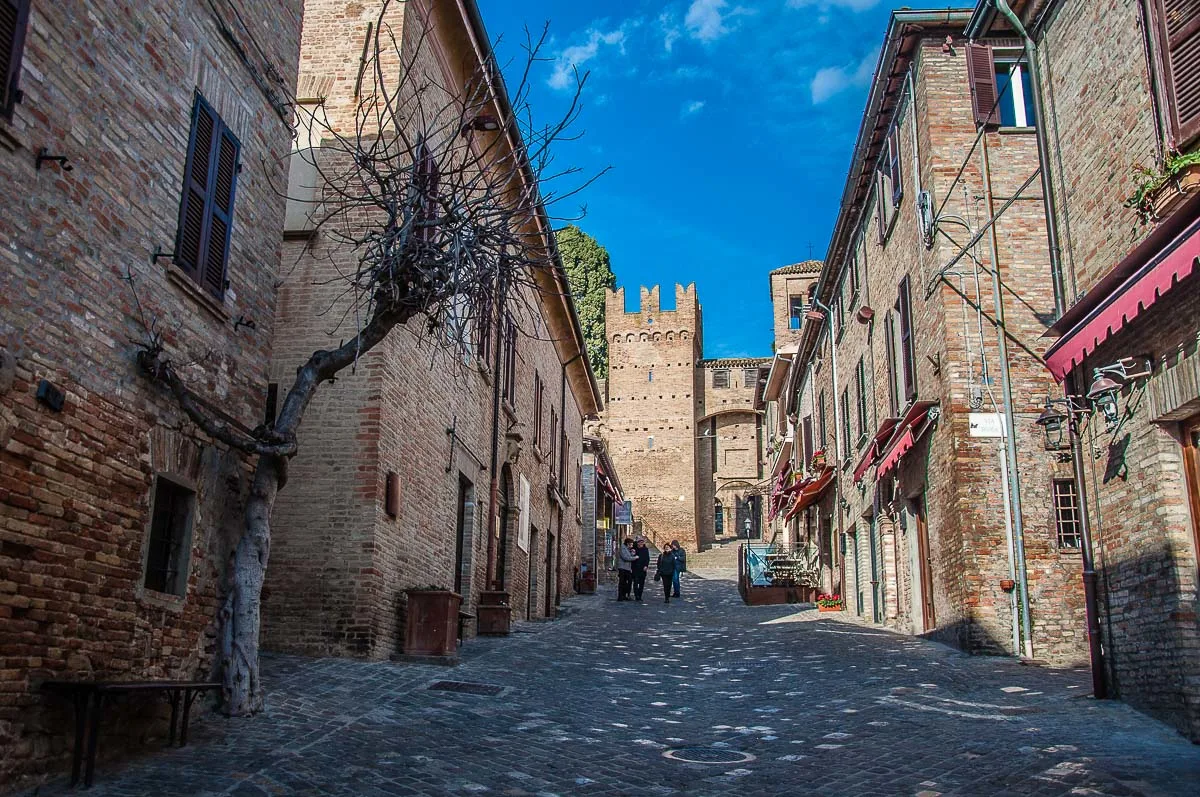
There are several buildings of interest in the fortified village of Gradara, Italy. Here is a shortlist in alphabetical order for your interest:
Casa del Gufo – an old house with a lovely garden with olive and cedar trees. It is used to stage events and organise activities aimed at kids.
Casa del Mercante – a reproduction of a medieval house with a bedroom and kitchen/workshop. All the furnishings faithfully represent medieval tastes and styles.
Palazzo Rubini Vesin – an elegant aristocratic residence built in the 18th century. It was used as Gradara’s Town Hall until 1992. Nowadays, it serves as an exhibition venue. Curiously enough, inside it is Gradara’s first theatre. With only 70 seats, it was built in the second half of the 19th century. It is still used to stage performances today.
8. Olive Garden in Gradara, Italy
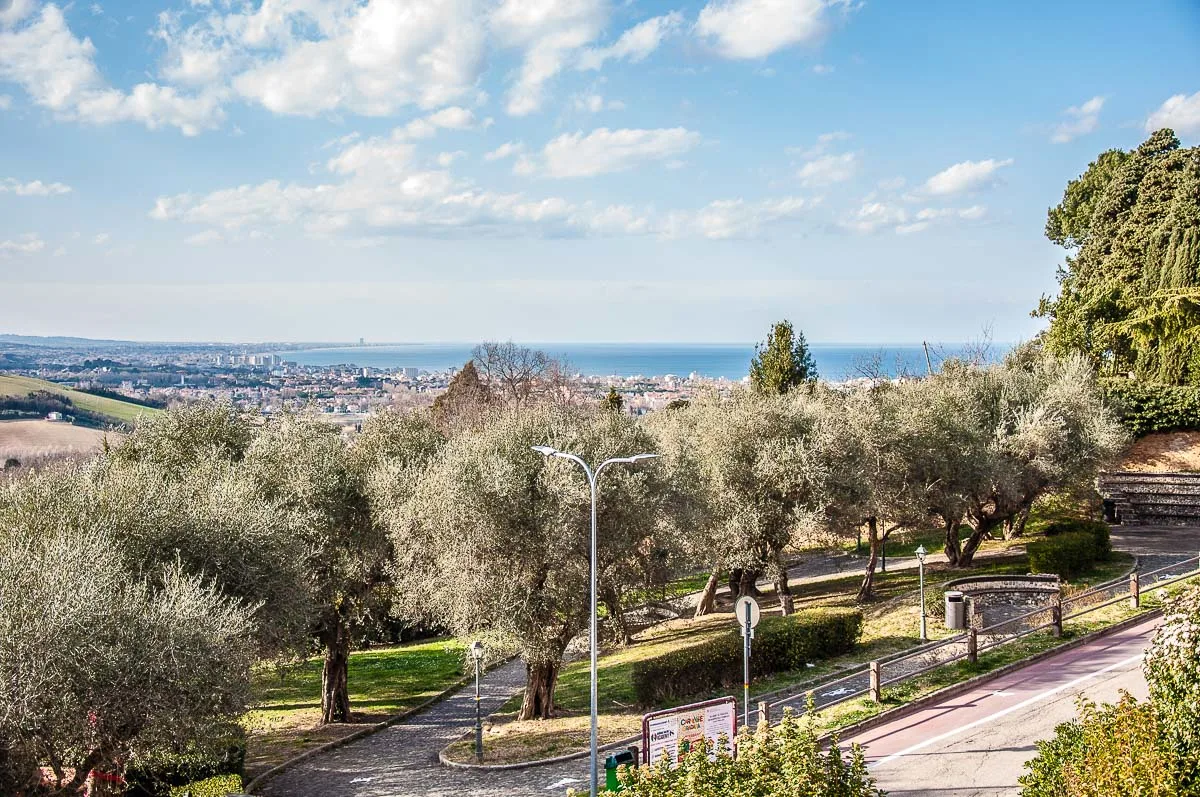
This lovely olive garden is just outside of Gradara’s mighty defensive walls. The small path that leads to it starts from Porta Nova.
There are 17 centuries-old olive trees here. Next to them, there is a small open-air amphitheatre. The olive grove is on the side of the hill on which the Gradara Castle is built. As such, it opens beautiful views of Italy’s Adriatic seaside.
9. Open-Air Theatre and Falconry Centre in Gradara, Italy
This is an ornithological park which houses many types of birds of prey. It stands just outside of Gradara’s defensive walls.
Shows are staged during the high season. You can see falcons, eagles, vultures, and owls. Falconry is an ancient art and a visit to the Falconry Centre in Gradara will help you learn many of its secrets.
10. Events in Gradara, Italy
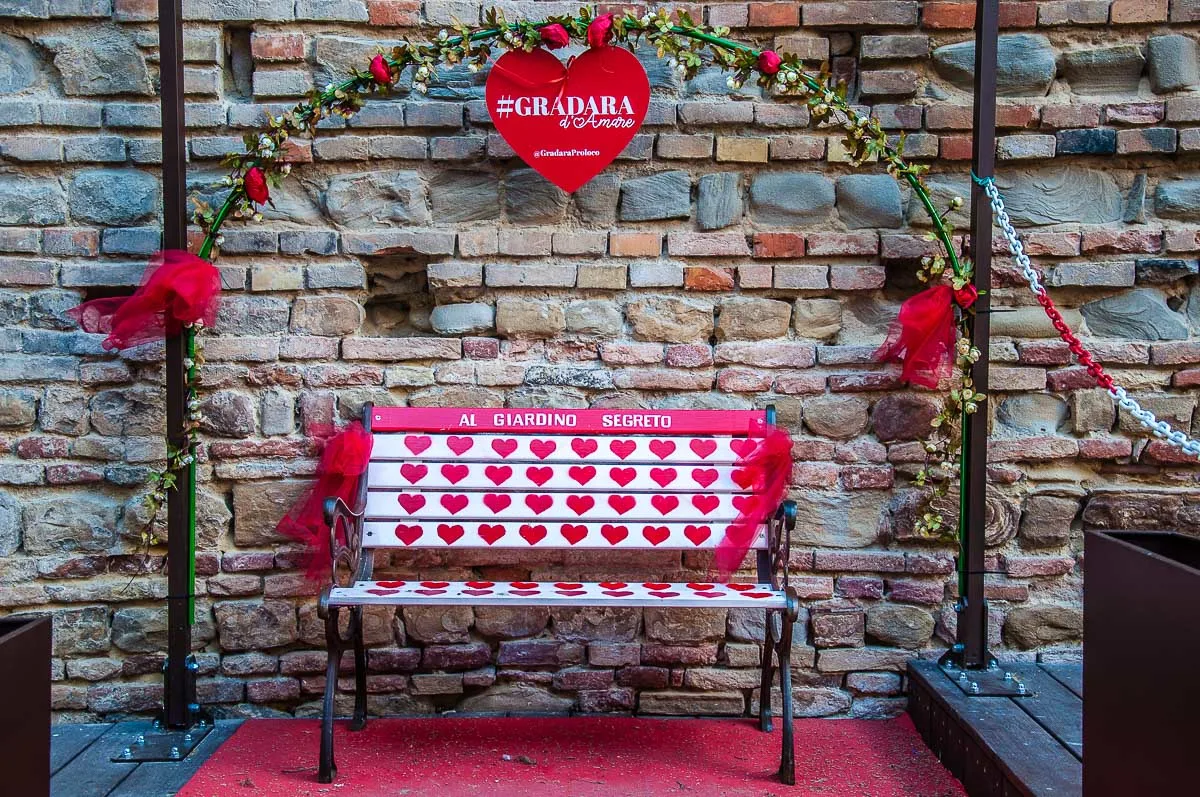
One of the best things about Gradara is the large number of lively and fun events that are staged here throughout the year. Attending one of Gradara’s events is a great way to be transported back to the Middle Ages and to experience this charming fortified village in Italy at its very best.
For your interest, here is a shortlist of some of the best events which are regularly held in Gradara:
- Thursday in the Castle – staged during the high season from mid-June to mid-September. Expect a parade with historic costumes, fire-eaters, and drum beaters.
- Siege of the Castle – this large-scale medieval reenactment is Gradara’s grandest event. It’s held on the penultimate weekend of July of even years. It replicates the 1446 siege of the Gradara Castle.
- The Dragon Castle – a magical and imaginative Celtic festival.
Gradara also marks several important holidays with special events and celebrations. Particularly famous are the events staged here for St. Valentine’s Day, Halloween, and Christmas.
N.B.: To finish this list of the ten best things to do in Gradara, Italy, I also want to mention that near the village, you can also visit the Gradara War Cemetery.
My Personal Experience of Visiting Gradara, Italy
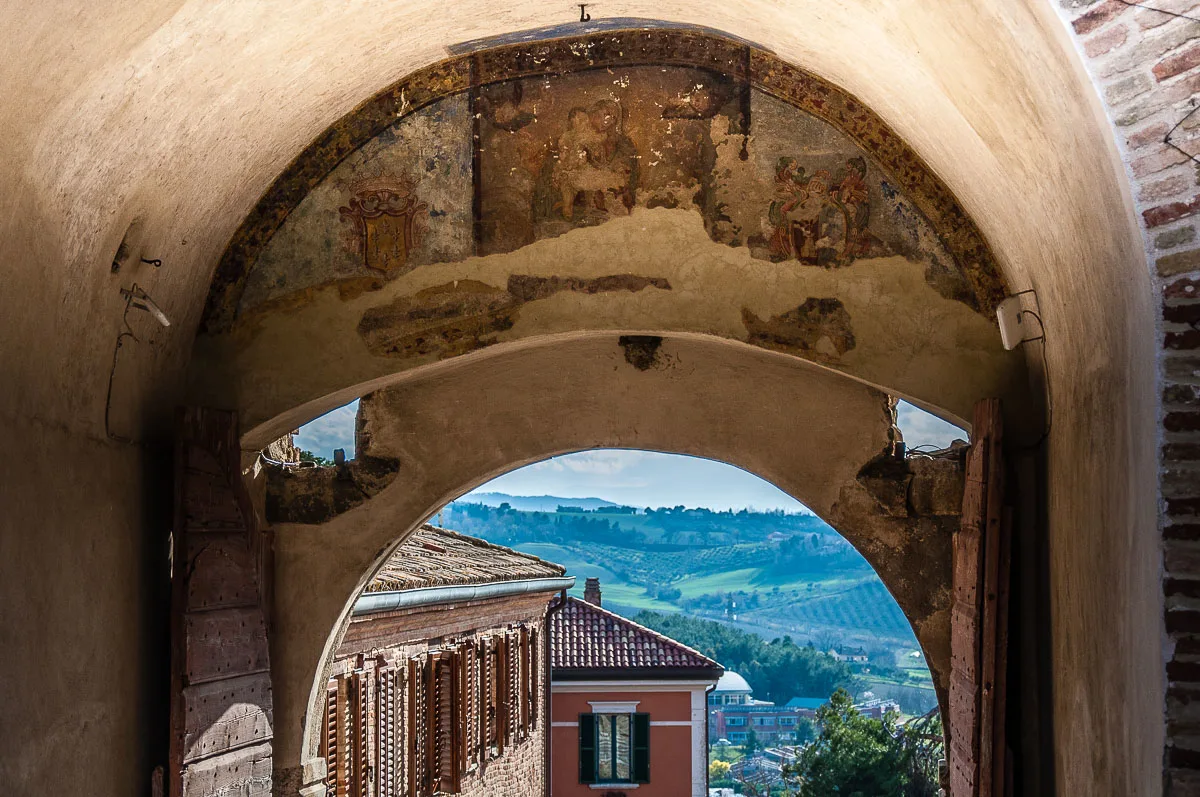
I spent a wonderful February day in Gradara just before Covid-19 hit Europe and put a full stop to all travelling and exploring.
At the time, we didn’t know yet what was about to happen and we were enjoying a great road trip through the lands of Emilia-Romagna and the Marche. The sun shone high in the sky and the trees were blossoming in the lush rolling hills around us filling the air with a beautiful spring promise.
Gradara had been on my radar since the previous year when we had also undertaken a road trip to the Marche. At the time, we had glimpsed its massive defensive walls looming over the Adriatica autostrada. Yet, we had already exhausted all our sightseeing time for that day in the nearby town of Fano. So, we had to drive past Gradara and continue on our way back to Vicenza in the Northern Italian region of the Veneto where we were living at the time.
I turned around to look at Gradara’s walls from the front passenger seat. I could hear the village’s call loud and clear. And I could only hope that before long we would be returning to properly see it.
So, when a year later we found ourselves driving near Gradara again, we made sure that we had plenty of time to spend in this pretty fortified village. As luck would have it, it was also the low season so it felt like we had the whole village to ourselves.
Gradara sits on top of a small hill. Its castle takes the prime position on the summit and then the houses spill down the gentle slope like the train of a marvellous medieval dress. Walking into the fortified village through the large Porta Firau, I couldn’t help but feel transported centuries back in time.
Gradara’s first building was erected in 1150 by two brothers – Piero and Rodolfo de Grifo. They had usurped Gradara’s hill from the comune of Pesaro. That very first structure had been a defensive tower. With the centuries that followed, the tower grew into a 30 m high donjon with a castle and a fortified village around it.
Some of the most powerful noble families of Italy of the Middle Ages and the Renaissance called Gradara home. Del Grifo were replaced by the Malatesta. Then came the Sforza. For a brief moment, the castle and its village were ruled by Cesare Borgia – the son of the much-feared Pope Alexander VI. Then, the Sforza took Gradara back. They were followed by the Della Rovere. And in 1641, Gradara came under the rule of the Papal States.
Two pieces of art from this era stand out to me when we walk around the castle, in and out of its many lavish rooms.
One is a painting by Giovanni Santi – the father of the infinitely more famous artist Raphael. It dates back to 1484 and it depicts the Virgin Mary and the Christ Child. Next to them stands St. Sophia. She holds a model of Gradara in her hands. It is the oldest known depiction of the fortified castle and its village.
Then, the chapel on the ground floor of the castle is adorned with a beautiful altarpiece by Andrea della Robbia. He was the nephew of the renowned Florentine sculptor Luca della Robbia. Both are famous for their terracotta pieces which are so beautifully glazed that it looks like pure light is streaming from them.
Around the 18th and 19th centuries, Gradara fell in a state of abandon, its mighty walls crumbling under the passage of time. Two earthquakes made things even worse. The first had hit in the 17th century and the second – in 1918. Then, in 1920, one man saw Gradara and fell in love with its castle. His name was Umberto Zanvettori. He was an engineer from the city of Belluno in the Veneto, a resident of Rome, and had made his money, they say, in South America.
Zanvettori bought Gradara and over the next eight years, he dedicated his life to bringing the castle and the village to their former glory. In doing so, some say, he employed creative freedoms in painting the rooms and furnishing them in a way that recreates the Middle Ages that may not be fully authentic. Yet, Zanvettori preserved Gradara for the next generations. He also safeguarded the memory of the families who had lived there throughout the centuries and the stories that make the castle feel so much more than yet another impressive building in the beautiful landscapes of Italy.
Nowadays, the rooms of Gradara Castle are adorned with the coats of arms of the noble families to whom it had once belonged. The profiles of Sigismondo Malatesta and his first lover and then wife Isotta degli Atti are replicated many times in the frieze of the castle’s large hall. Without a doubt, Sigismondo is one of the most interesting characters of the Italian Renaissance. He was both a refined man of exquisite taste and a brute capable of life-shattering violence. His contemporaries feared him and hated him. At the same time, they used his acumen as a military commander when the situation required it.
Yet, between the names of the many men who had lived, ruled, and sometimes committed unspeakable acts in Gradara Castle, it was the stories of the women that had called Gradara home that really stood out to me.
Starting with Francesca – more of a literary heroine than a real-life personality. Her myth, irrespective of scarce documentary proof, is interlaced with that of Gradara. Dying for her love, nowadays she is considered a trailblazer for women’s rights to choose freely who they fall in love with.
So enamoured was Umberto Zanvettori with Francesca’s myth that he had a room in Gradara Castle outfitted as the place where she and Paolo met their end at the hands of Gianciotto – Paolo’s brother and Francesca’s husband.
Then, you have Lucrezia Borgia – a tender 12-year old who in 1493 was betrothed by her father – the fearsome Pope Alexander VI – to Giovanni Sforza, the ruler of Gradara. To make the castle acceptable for his bride who had grown surrounded by the lux of Rome, Sforza undertook a large-scale renovation. The frescoes painted at the time in Lucrezia’s dressing room survive to this day. Greatly faded and highly allegorical, they have witnessed history being made at a time when girls and women were merely pawns in their fathers and husbands political games.
The union between Giovanni Sforza and Lucrezia Borgia didn’t really have a happy ending. Three years after their wedding, Giovanni was forced to declare that he was impotent and thus have his marriage to Lucrezia annulled. The girl was shipped off by her father to another husband and then another and another, growing in the process to become one of history’s most legendary female figures for all the strange and twisted reasons.
Gradara Castle was a wedding present for yet another noble bride. Vittoria Farnese married Guidobaldo II della Rovere in 1547. Gradara became her personal property and she governed it with an expert hand. Vittoria’s court attracted many musicians, artists, and intellectuals. Under her guidance, the production of prized silks and refined faience bloomed in the lands of her husband. Unfortunately for Vittoria, upon her husband’s death, she had to rescind ownership of Gradara.
The last ‘lady of the castle’ so to speak was Alberta di Porta Natale – the wife of Umberto Zanvettori. Upon his death in 1928, he left Gradara to the Italian State with the provision that his wife could spend the rest of her life here. They say that she dedicated herself to the restoration and maintenance of Gradara and would spend several months each year here. After her passing in 1983, the village and the castle were fully opened to the public.
It’s easy to fall under Gradara’s many charms. You just need to go for a walk up and down the village’s main street, to stray into its small side alleys, and to stop to admire the vast views that open from the defensive walls over the sparkling Adriatic Sea and the Marche’s lush rolling hills. The village – medieval in its essence – has been extensively restored and made comfortable for tourists seeking to experience the Middle Ages. What’s truly authentic about Gradara are the stories. The stories of the people who lived, loved, and committed acts of love and betrayal here.
And to learn them and see where they happened is a great reason in itself to travel to Gradara!
When Is the Best Time to Visit Gradara, Italy?
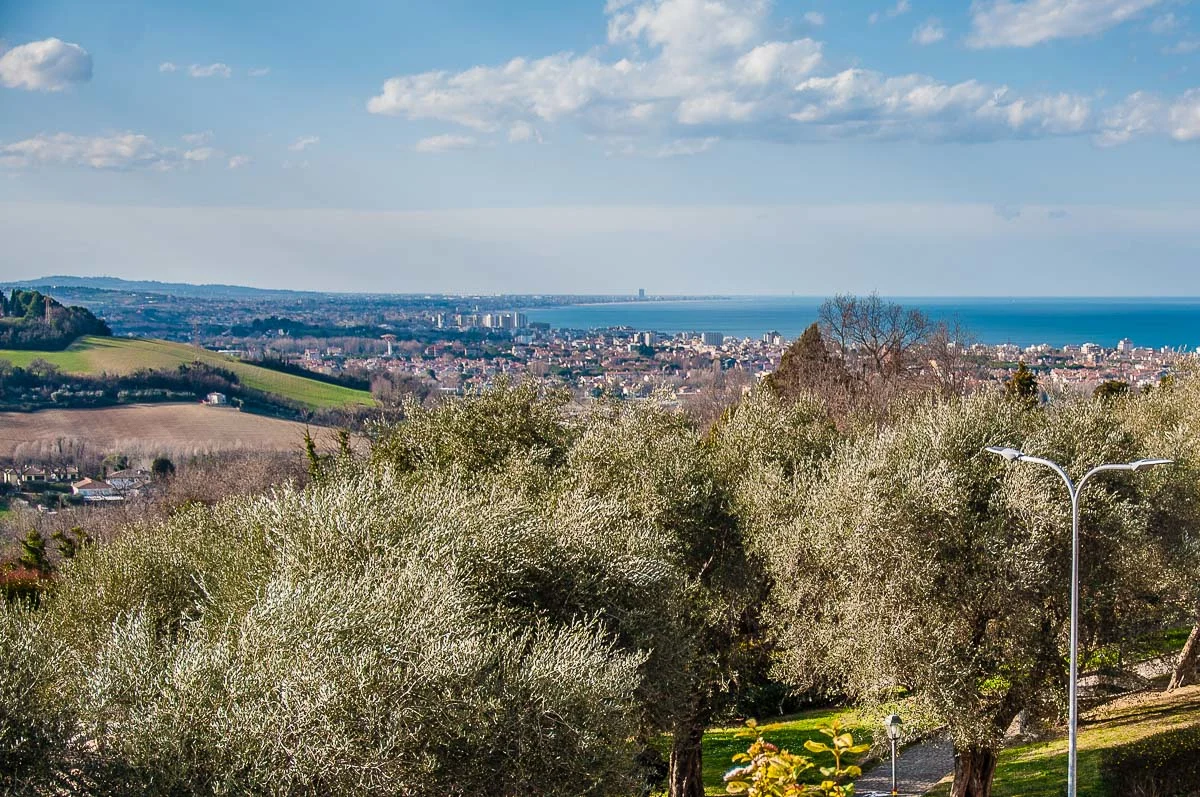
I feel that Gradara is best visited on a clear and sunny day!
This way you will be able to better appreciate the village’s stunning setting between Italy’s gorgeous Adriatic seaside and the gently rolling hills of the Marche.
At the same time, as we can’t simply order the perfect weather for when we travel (otherwise, life would be almost ideal), don’t miss an opportunity to visit Gradara even if the sun is not shining bright on the particular day you are going to be there.
During the high season and on days with events, Gradara can get busy. After all, this is one of the most visited tourist sights in Italy. During the low season, some of the onsite restaurants may be closed for a seasonal break.
If you are planning to spend only a few hours in Gradara, then factor in riposo – the extended Italian lunch break. The village’s History Museum, for example, closes at lunchtime even during the high season. You can check its current opening times on its official website. It’s in Italian and if you need help to get the gist of it, Google Translate may come in very useful indeed.
All in all, Gradara is easy to navigate. Bear in mind that its historic centre is built on a hill and there is a slight elevation as you are walking up to the castle. The castle crowns the hill at a height of 142 m. It’s not difficult to navigate even if you are not particularly sporty. There are lots of shops, bars, and restaurants along the way to stop and catch your breath if you need to.
How to Reach Gradara, Italy?
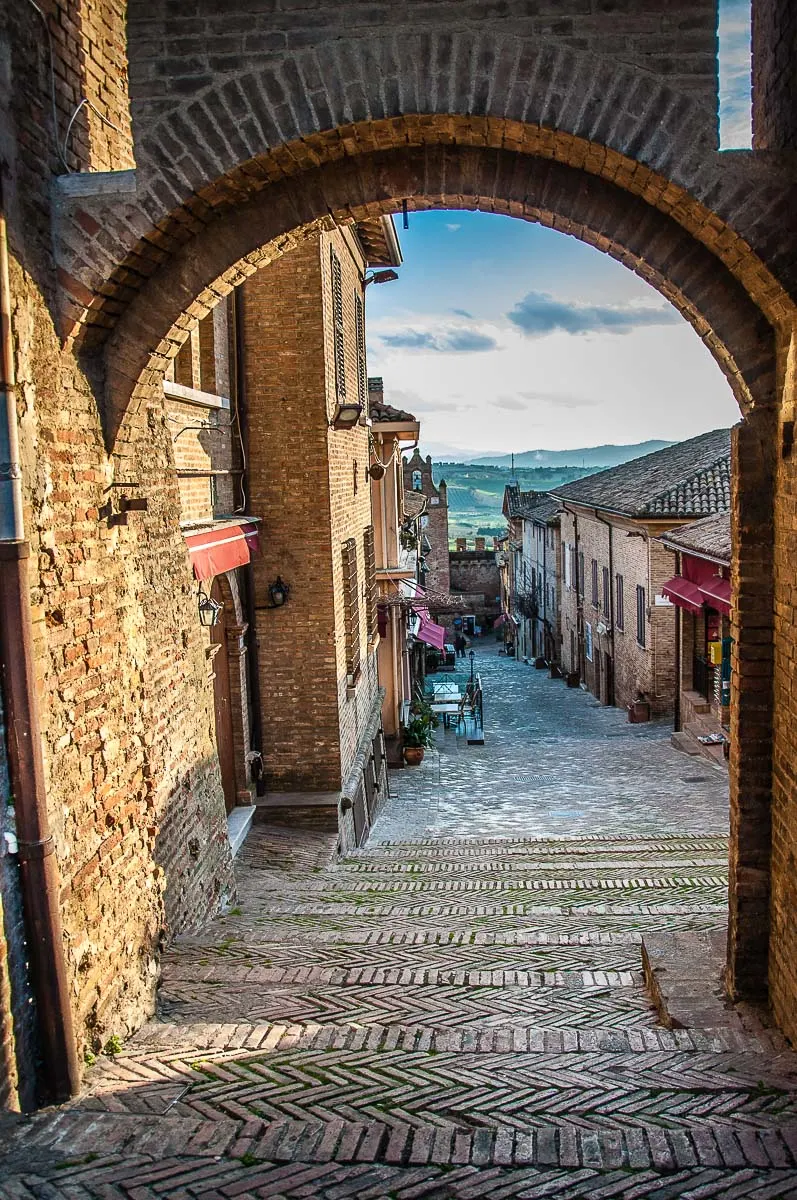
Gradara is very easy to reach by car, train, and local bus. Close to several important towns, cities, and tourist resorts in Italy as well as to San Marino, Gradara is not difficult to visit.
By Car
Gradara is right next to the Autostrada Adriatica/A14. This is Italy’s second-longest motorway. It’s very easy and fast to travel on it. So driving times from nearby cities, towns, and resorts such as Rimini, Pesaro, Urbino, and even Ancona and Bologna are from very short to incredibly manageable. Just be prepared for the Italian assertive style of driving. Also, this very helpful website will give you an estimate of how much the tolls are going to cost depending on your point of departure.
There is a large paid-for car park right next to the defensive walls of Gradara. You can see it on Google Maps here. This is where we parked. As we visited Gradara outside of the high season, there were many free parking spots. Otherwise, this official link provides information on car parks and their respective tariffs in the area. It’s in Italian and if you need help to get the gist of it, Google Translate may come in very useful indeed.
The Parcheggio dei Cipressi is another nearby car park that is also specifically equipped for campers and campervans. You can find information about it here. Again, it’s in Italian.
By Bus
Gradara is served by regularly running public buses.
Line 130 runs from Pesaro to Gabicce to Cattolica to Gradara. Line 131 starts from Gradara and runs to Cattolica to Gabicce to Pesaro. If you are travelling from Rimini to Gradara, then you can take bus 125 or bus 134 to Cattolica train station (officially known as Cattolica-S.Giovanni-Gabicce). Once there, you will need to take bus 130 to Gradara.
For specific timetables, please, have a look at this page on Gradara’s official website. It’s in Italian and if you need help to get the gist of it, Google Translate may come in very useful indeed.
By Train
Gradara doesn’t have its own train station.
You will need to travel to the train station of Cattolica (officially known as Cattolica-S.Giovanni-Gabicce) or of Pesaro. Upon arrival, you will need to take bus 130 to Gradara.
For train travel times, ticket prices and booking tickets in advance, you can use the official website of the Italian State Railway: TrenItalia (in English).
How Long to Spend in Gradara, Italy?
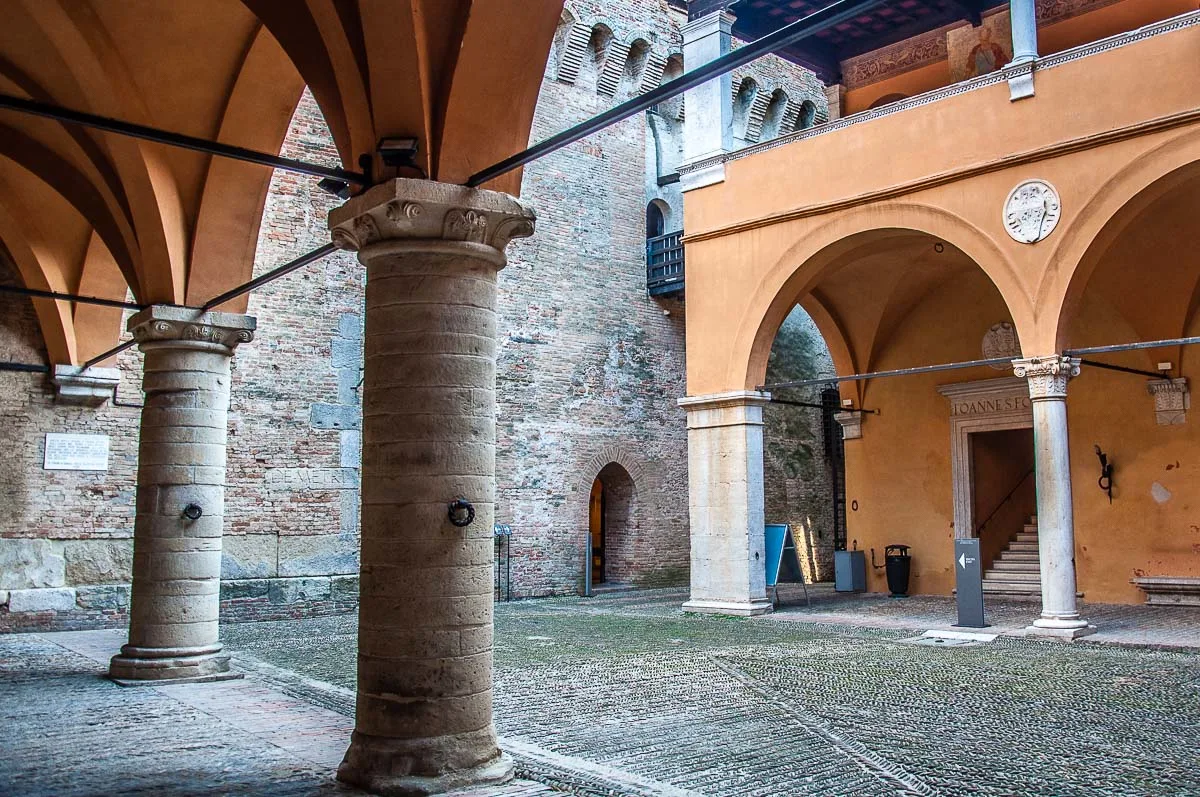
How long to spend in the Italian village of Gradara depends entirely on you and what your travel plans and personal interests are.
Compared to the large Italian cities, Gradara is tiny. Its historic centre is easily navigable on foot from one end to the other. If you are a quick sightseer, you can comfortably fit the main sights here in a couple of hours and then enjoy a nice Italian coffee or a lovely local meal before heading to the next destination on your list.
In case your visit falls on a day when one of Gradara’s famous events is taking place, then pencil in half a day or a full day for the village in your travel plans.
If you want to experience the peace and quiet of this beautiful corner of Italy, then consider spending the night in Gradara. There is nothing like waking up at sunrise in a centuries-old Italian village and feeling like you have all its beauty for yourself. Plus, this way you can spend some time exploring some of the art cities, historic towns, and sea resorts that are only a stone’s throw away from Gradara.
What Else to Do Around Gradara, Italy?
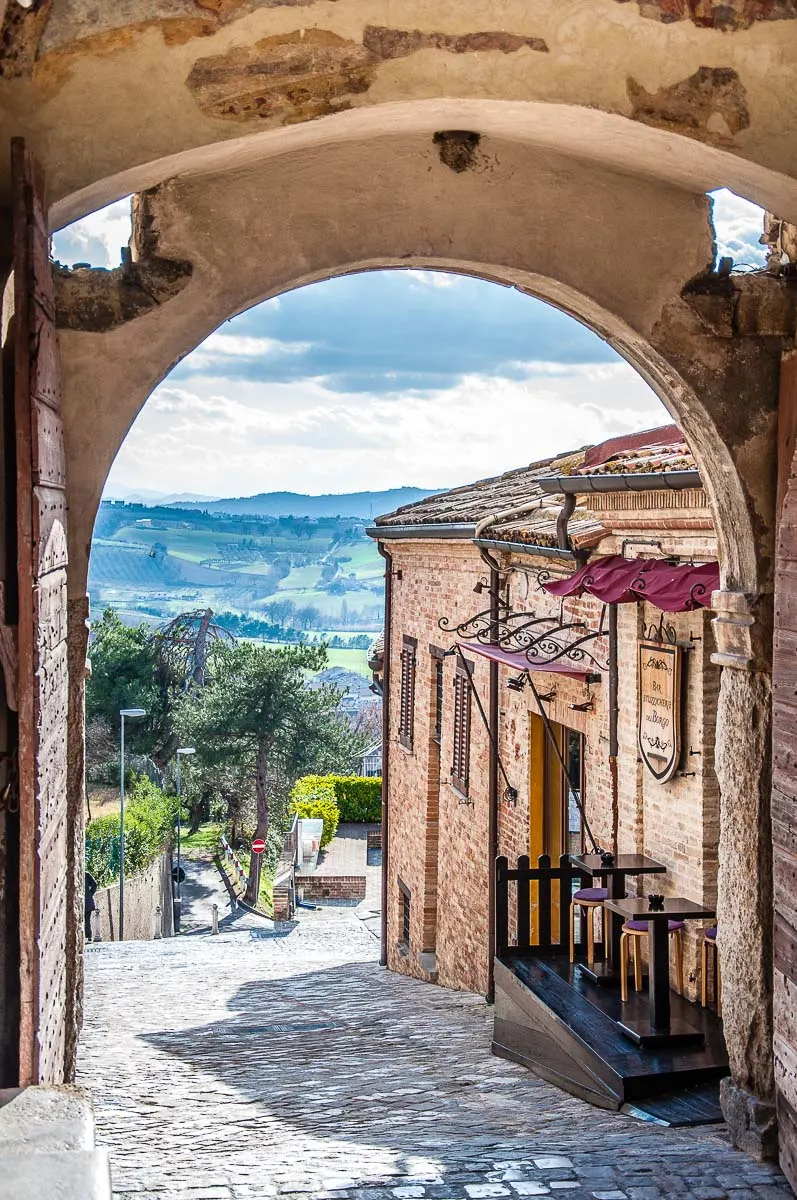
There are many things you can do and enjoy in the vicinity of Gradara, Italy. It all depends on your interests and how much time you have at your disposal.
Gradara has a very strategic location on the border between the Italian regions of the Marche and Emilia-Romagna. The village is in close proximity to some of the best art cities, historic towns, and tourist resorts on this side of Italy. Most importantly, sitting on a hilltop on the edge between the sparkling Adriatic Sea and the hilly countryside, Gradara offers access to all sorts of activities – from sunny days on the beach to lovely hikes in the bosom of nature.
Cattolica – the town closest to Gradara – is a well-known Italian sea resort with great beaches. The town also has a must-see aquarium which is the largest on the Adriatic Sea and the second-largest public aquarium in Italy.
A short driving distance away from Gradara, you can visit the art cities of Pesaro and Urbino. The first is famous as the birthplace of the famous Italian composer Gioachino Rossini. The other flourished during the Italian Renaissance and was where the great artist Raphael was born.
Fano and Ancona are also very easy to reach from Gradara. Fano is a millennial town with a rich Roman heritage and extravagant Carnival traditions. Ancona is the capital of the Central Italian region of the Marche of which Gradara is also part.
In case you are interested in nature, then the stunning Frasassi Caves – one of the most beautiful and most popular tourist caves in Italy – are just an hour and a half away from Gradara. Click here to find out how to visit the Frasassi Caves and what to see in their vicinity.
About 40 mins away from Gradara, Italy, you can also visit San Marino. This is the world’s oldest republic and fifth-smallest country.
If you prefer to explore the Northern Italian region of Emilia-Romagna, then you will also be spoilt for choice. Gradara is within very close proximity to some of the most beautiful and historic towns, villages, and cities here. From Ravenna, Rimini, and Cesena to Bologna and Ferrara, Gradara is a great starting point to explore these rich in terms of beauty, art, and history Italian destinations.
In Conclusion
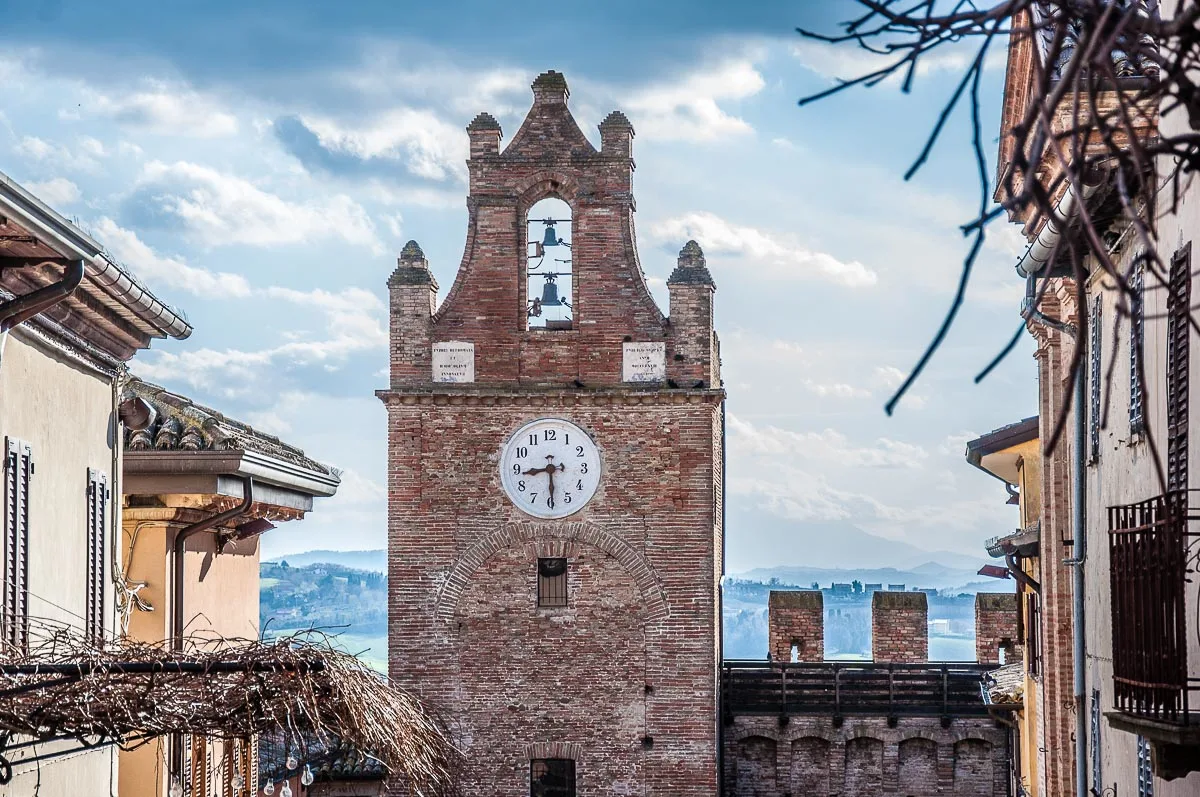
Gradara is a small village in the Italian region of the Marche. With a history that spans centuries, impressive medieval fortifications, and a hilltop setting overlooking the sparkling Adriatic Sea, it was officially voted Italy’s most beautiful village for 2018.
Known as the location of one of the most famous tragic love stories of Europe’s Middle Ages – that of Paolo and Francesca – Gradara is a must-see destination in Italy. Especially, if you have always dreamt of finding yourself in a medieval scene with a majestic castle. Gradara also offers gorgeous views, lively events, and lots of curious corners to explore.
In the above blog post, I give you detailed information on how to visit Gradara, Italy and experience all that it has to offer. From how to reach the village by car, train and bus to an extensive list of the best things to do in Gradara, this page has many first-hand tried and tested practical tips to make your visit all the smoother and more enjoyable.
I hope that the information provided will inspire you to put Gradara on top of your Italy’s bucket list and that as soon as possible you will head to this exciting and beautiful corner of Italy to see it first hand.
Enjoy your trip to Gradara, Italy!
More Helpful Info for You About Italy’s Most Beautiful Villages
Why Visit Italy’s Villages: Italian Villages
Italy’s Most Beautiful Villages: Venzone (for 2017)
Friuli Venezia Giulia: Most Beautiful Villages
Emilia Romagna: Most Beautiful Villages
Veneto: Most Beautiful Villages
More Helpful Italy Info for You
Northern Italy: 18 Best Cities to Visit
Veneto: Best Cities to Visit, Top 15 Places, 30 Adventures, 15 Most Colourful Places
Best of Italy: Italian Piazzas, Italian Food, Italian Markets, Italian Coffee Culture
Lake Garda: Best Towns, Nearest Airports, Travel Options, Lake Garda with Kids
Lake Como: Things to See
Venice: Hidden Gems, Boats in Venice, Day Trips from Venice
Verona: Things to Do in One Day, Day Trips from Verona
Padua: Things to Do in One Day, 101 Facts About Padua, 10 Reasons to Visit Padua, Day Trips from Padua
Vicenza: Things to Do, Day Trips from Vicenza
Thank you for reading! Please, leave me a comment, pin the image below or use the buttons right at the top and at the end of this blog post to share it on social media.
For more useful information like this, please, like my blog’s page on Facebook and subscribe to my strictly no-spam newsletter.
